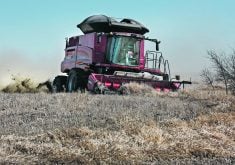Wide-row spacings risky
Many producers prefer 12-inch row spacing to lower the capital and operating costs of their seed drill.
To determine if row spacing affects yield, Brian McConkey and Perry Miller, researchers at the Agriculture Canada Semiarid Prairie Agricultural Research Centre at Swift Current, Sask., are testing a narrow seed spread on a 12-inch row spacing versus eight-inch row spacing. Results for 1995 and 1996 on a loam soil in southwestern Saskatchewan showed a high risk of more than a 10 percent yield loss when a narrow seed spread is used on a 12-inch row spacing.
Read Also

VIDEO: Green Lightning and Nytro Ag win sustainability innovation award
Nytro Ag Corp and Green Lightning recieved an innovation award at Ag in Motion 2025 for the Green Lightning Nitrogen Machine, which converts atmospheric nitrogen into a plant-usable form.
The opener used on both row spacings spread the seed over a two-inch width in a split row. Fertilizer was placed between the split row so that it was one inch below and one inch to the side of the seeds.
Spring wheat, durum, flax, lentil, mustard, field peas and chickpeas were seeded directly into wheat stubble and into conventionally tilled fallow.
Yields of fallow and stubble chickpea, semi-leafless field pea and normal-leafed field pea were not affected by row spacing. For spring wheat, durum, flax, lentil and mustard seeded directly into standing stubble, the yields in both years averaged 12 percent less for the 12-inch spacing versus eight-inch spacing.
Under better-than-average moisture conditions of 1995, yields of all crops seeded on fallow were similar at both row spacings. In 1996 with average growing conditions on fallow, spring wheat, durum, flax, lentil and mustard yielded 11 percent less on the wider row.
For all crops grown on both stubble and fallow, when the seeding rate was reduced to two-thirds of the recommended level, the yield loss for the 12-inch spacing versus the narrower spacing was increased.
Results similar to these have been reported in semi-arid areas throughout the world. The decrease in crop competitiveness against weeds in wide row spacings is well known and accounts for much of the reported yield losses. Lower yields are also due to the closer plant-to-plant spacing along the rows spaced 12 inches apart compared with the eight-inch spaced rows.
Additional stress
Closely spaced plants compete more with each other for water, nutrients and sunlight. Where plant growth is vigorous, such as well-fertilized production on the best soils of the parkland region, the crop can often overcome this additional competition. However, in lower yield areas such as southwestern Saskatchewan, where growth is less vigorous, crops are less likely to overcome this stress.
Finally, the crop sown with a narrow seed spread on a wide spacing takes longer to cover the soil and this can increase moisture loss from soil between the rows.
The results to date suggest that row spacing recommendations developed for high-production areas of the parkland are not suitable for drier parts of the Prairies.
In particular, at Indian Head in eastern Saskatchewan, a narrow seed spread on a 12-inch row spacing has resulted in yields equal to eight-inch row spacing. When the grain yield potential at Swift Current about equals that of Indian Head, the spring crop yields were unaffected by row spacing. Unfortunately, many drier prairie regions can’t count on high yield, so a narrow seed spread on 12-inch row spacing carries a high risk of yield loss.
A 12-inch row spacing has potential benefits including a lower initial cost of the drill, reduced machine draft and maintenance and better packing action. For direct seeding, a narrow seed spread on wider row spacings reduces plugging with crop trash. However, producers in lower production areas, or those with weed concerns or poor crop emergence, should consider carefully if the benefit outweighs the high risk of obtaining lower yields.
– Agriculture Canada














